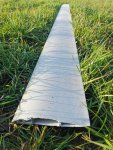Steve_UK
Active Member
- Joined
- Oct 15, 2010
- Messages
- 3,887
- Location
- UK
- Aircraft
- I'm not a pilot but have been lucky enough to fly in Mi-24 Hind, Mi-2, Mi-17, Lynx HAS3, Gliders, GA
The Polish Civil Aviation Authority ( ULC ) issued an Airworthiness Directive on 25-11-19 regarding the duralumininium blades used on Xenon / Zen1 / Tercel / Argo gyros.
There was a nasty fatal accident in November 2019 near Warsaw killing an instructor and student - I understand one rotor broke off in flight.
The link below will take you to the AD - scroll through it and you will notice that paragraphs alternate between Polish and English.
In summary blades with under 1,000 hours then inspect regularly - blades over 1,000 hours do not fly them.
Please read the document yourself, I may have read it incorrectly.
Link to Airworthiness Directive PDF here
Fly safe
There was a nasty fatal accident in November 2019 near Warsaw killing an instructor and student - I understand one rotor broke off in flight.
The link below will take you to the AD - scroll through it and you will notice that paragraphs alternate between Polish and English.
In summary blades with under 1,000 hours then inspect regularly - blades over 1,000 hours do not fly them.
Please read the document yourself, I may have read it incorrectly.
Link to Airworthiness Directive PDF here
Fly safe






